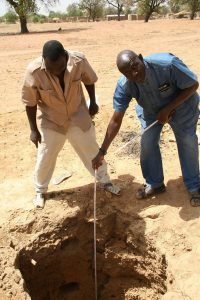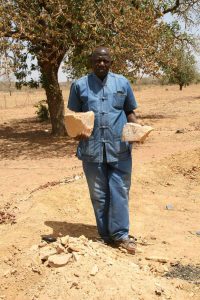
Water is life
Feb. 12 | 2018
Water has a considerable impact on all aspects of human health and wellbeing, including: nutrition, spirituality, peace, social consideration, power, resilience, education, economical and financial development, longevity, reproduction, creativity, ingenuity, citizenship, patriotism, and many other factors.
In dry areas in Mali, including Common Pastures’ intervention zones in Koulikoro, Sikasso and Ségou regions, digging a well remains mostly the only way to get water, except moving the village, with all the bother to do so.
Growing trees to feed small ruminants requires a steady source of water throughout the year. That’s why Common Pastures is helping the Katibougou region of Koulikoro to drill a well in their one hectare forage trees planting demonstration site. The utmost purpose of the well is to supplement planted young forage trees with water during the dry season from November to May, with rains compensating the rest of the year to ensure normal growth to plants.
In addition, if the water from the well is potable and tastes good to drink, the community will use it for home consumption and other purposes like home building, washing, agricultural products processing, hygiene and sanitation.

Project faces obstacles
In Katibougou, a well needs to reach eight to 10 meters to get yearlong water. Before Common Pastures intervened, the cooperative was able to reach three meters in the well. Common Pastures assisted in achieving three additional meters before reaching a rocky subsoil. Getting deeper required intervention of a specialist rocky well digger, who reached one additional meter and then became sick for a very long time.
The cooperative decided to wait until March when ground water will be at the lowest level to continue digging the well. When the well is finished, the cooperative will set up a forage tree nursery in April and the trees will be planted in May-June to coincide with the starting of the rainy season, which will give them a chance of great success.
How wells are dug in Mali
In rural areas in Mali, especially in the village of Katibougou, digging a well goes mostly through the following process:
1. Water site identification: The claimant asks for the service of a local quack well-known for identifying water. He makes some sacrifices (colas nuts, fresh milk, chicken, cereals according to his prediction) and tells the day he will come to the area. The D-date he can show up to three places to the claimant, who should turn upside down one new calabash (large woody gourd) at each point. The following morning, the claimant will come and reverse the calabaches one by one and assess which one sweat the most. That is the selected site for the future well. There is not any fixed price for this service–the generosity of the claimant prevails (money, cola nuts, chicken).

2. Digging the well : There are two types of well-diggers according to the subsoil structure: loose subsoil digger and rocky subsoil digger. Upon agreement on the price regarding the width (2 meter diameter) and the depth (8-10 meters), the loose digger starts digging and continues until a rocky surface appears, then agreement is made with the rocky subsoil digger. If one meter depth of loose subsoil can cost $25 (12.500 F CFA), for the rocky subsoil, the price can reach $100-150 per meter as the work is done by using chisel, hammer and sticks of explosive to crack the rock. According to the nature and the size of the rock at the bottom of the hole, 3 to 4 small holes of 5cm x 20cm are created to introduce explosive sticks ($8 each) linked to a detonator connected to a battery by a long wire (20-30 meters) away.

3. The super-structure is created: After digging the well, it is always recommended to build the super-structure, which includes the water tank and edge with padlocked cover to protect the well from animals and impurities brought by wind. Troughs should be foreseen for animals and plant watering.
The total cost of setting up a well in rural Mali is at least $1,000-1,500.

